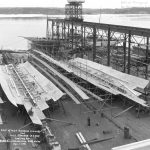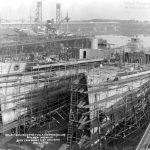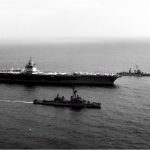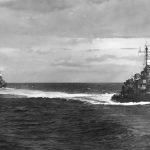USS O’Bannon, BIW Hull 191, was BIW’s second Fletcher-class destroyer, launched on Feb. 19, 1942, along with her sister ship Nicholas, Hull 190. The new destroyer was delivered in Boston on June 4, and was commissioned on June 26. Nicholas and O’Bannon were the first of class to be laid down, launched, and commissioned – just ahead of the class leader, USS Fletcher herself.
In the early days of WWII, new destroyers were urgently needed in battle. So after a brief training period, O’Bannon sailed from Boston on Aug. 26, bound for the South Pacific. There she joined Destroyer Squadron 21, which included Nicholas and several BIW-built sister ships, escorting convoys and other warships among the island chains.
Early on the morning of Nov. 13, 1942, O’Bannon was part of a US force that intercepted a much larger Japanese fleet attempting to bombard the contested island of Guadalcanal. The brief close-quarters battle pitted US destroyers against Japanese battleships. The US force was decimated but it succeeded in stopping the bombardment force and protecting Guadalcanal.
Through the remainder of 1942 and into 1943, O’Bannon continued to patrol among the islands of the South Pacific. She sank the Japanese submarine Ro-34 in April 1943, and fought in the Battle of Kula Gulf and the Battle of Kolombangara in July.
In October, O’Bannon engaged in another close-quarters fight at the Battle of Vella Lavella, where she was heavily damaged but did not sink and was able to rescue the survivors from USS Chevalier, BIW Hull 192, which was destroyed in the battle. After temporary repairs, O’Bannon sailed for the United States for an overhaul and a much-needed rest. The respite was short, however, and by March of 1944, O’Bannon was back in the Pacific, where she continued her duties through the fall of 1945.
As the war came to a close, O’Bannon, along with Nicholas and USS Taylor (BIW hull 194), were selected to escort the battleship Missouri into Tokyo Bay for the signing of the surrender documents. O’Bannon was awarded the Presidential Unit Citation and 17 battle stars for her WWII service, more than any other destroyer.
After a brief period in reserve after the war, O’Bannon was modernized and recommissioned in 1951, along with Nicholas, for service off Korea and across the Pacific for wide-ranging duties including atomic tests and visits to allied countries around the region. During the 1960’s her duties shifted to include deployments off Vietnam, escorting aircraft carriers and providing gunfire support for troops ashore.
By 1970, O’Bannon – now approaching 30 years of age – was reaching the end of her life. With the arrival of missiles, advanced electronics, and larger, more capable destroyers, the Fletcher class destroyers slowly passed into history. O’Bannon and Nicholas were together again for their decommissioning on Jan. 30, 1970, and both ships were scrapped soon after.




